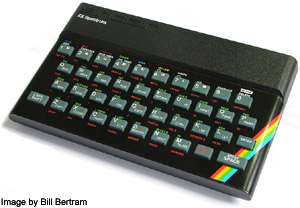ZX Spectrum

Britain's equivalent to the Apple II and Commodore 64.
And the polar opposite of the X68000 as well (in hardware specs).
The Sinclair ZX Spectrum, or "Speccy" to its fans, is a masterpiece of early 1980s computing Minimalism. Everything is as simple and cheap as possible. Because of this, it became famous in Britain and Spain in the 1980s, and eastern Europe and Russia in the 1990s, as a game-friendly home computer for people who otherwise couldn't afford one.
The Speccy is based on a couple of earlier computers, the ZX80 and ZX81. These were little more than a Z80 processor, an incomplete 4K version of BASIC, 1K of RAM, and a membrane keyboard — the first releases were sold as kits. The Z80 drew the text-only screen (when it wasn't busy), video output was to a TV set, and programs were stored on audio cassettes. The primitiveness was deliberate — the ZX80 was designed to be the cheapest computer on the market, and the ZX81 made the original design even cheaper. The ZX81 was only £70 (or $100) in 1981, and sold over a million units. The Speccy, designed to be the cheapest color computer on the market, improved on the ZX81 with a 16K almost-complete BASIC, 16K or 48K of RAM, a video chip, a beeper, and a rubber keyboard.
The Speccy was released in April 1982 at £125 for the 16K model and £175 for 48K, dropping as time went on. Sinclair was swamped with orders. It held its own against the Commodore 64, and British competitors such as the BBC Micro and Amstrad CPC. Sales figures went into the millions, mostly of the 48K model, and it brought Britain into the home computer age (and earned its inventor, Clive Sinclair, a knighthood [1]).
The Spectrum+, introduced in 1984, replaced the rubber keyboard with a plastic one, modeled after the failed Sinclair QL (an abortive attempt to create a business machine to compete with the IBM PC), and fixed some graphics bugs. The third and final Sinclair Spectrum was the 128, in 1986. This had 128K of RAM, an even better BASIC, MIDI, a monitor port, and three-channel sound.
Amstrad bought Sinclair in 1986 and continued improving the Speccy with a full-travel keyboard, an internal cassette drive, and finally with a disk drive in 1987. But these later models have backward-compatibility problems.
The demise of the Speccy in the early 1990s isn't the end of the story. Because it's so simple, it's easy to clone. The first Speccy clone was an authorized version by Timex (yes, the wristwatch company) for the United States, Portugal and Poland. Unauthorized Speccy clones started appearing in the Soviet Union in the mid-1980s, followed by several countries in eastern Europe, along with India, Brazil and Argentina. It's still made today in Russia.
The fansite World of Spectrum, which is officially endorsed by Amstrad, offers various emulators for the system and most of the original games for free as memory dumps or tape images. [2] The site has gone all out to ask the original producers of the games for permission to distribute them freely (permission which has been granted in the majority of cases, the exceptions mostly being games published by companies that still exist who fear that they compromise the integrity of their current catalogs by allowing free download of something that ceased to be profitable to them in 1993). Nevertheless, the site has about 90% of the computer's software library up for free legal download.
Specifications:
- Zilog Z80 CPU, 3.5 Mhz.
- Semi-custom graphics chip (off-the-shelf logic array with custom functionality).
- Spectrum 128 and Amstrad models: General Instruments AY-3-8912 sound chip.
- Spectrum: 16K or 48K.
- Spectrum+: 48K.
- Spectrum 128 and Amstrad models: 128K.
- 256x192 resolution.
- 8-color palette, with two brightnesses per color.
- Two colors per 8x8 pixel block (both had to be the same brightness, as the Speccy's display was famously idiosyncratic — each pixel block was represented as 3 bits of foreground color, 3 bits of background colour, 1 bit for brightness, and 1 bit for flashing...a total of 8 bits, or 1 byte).
- Spectrum and Spectrum+: Beeper.
- Spectrum 128 and Amstrad models: Three channels, square or noise waveforms, 10 octaves, programmable ADSR, 8-bit sample playback.
Games:
Thousands upon thousands; conservative estimates hover around the 11,000 mark [3], while the World Of Spectrum library contains around 9,000 of them.
- Ant Attack
- Eric and the Floaters
- Chuckie Egg
- Cylu
- The Dizzy series
- Elite
- Exolon
- Head Over Heels
- Jetpac
- Manic Miner
- Jet Set Willy
- Jet Set Willy 2
- Jet Set Willy
- The Sabre Man series
- Sabre Wulf
- Underwurlde
- Knight Lore
- Pentagram
- Skool Daze
- Back To Skool
- Star Control (unofficial port, very inferior to the original)
- Some RTS which most certainly isn't Stonkers. [4]
- Technician Ted
- Turrican
- ↑ {well, except for the little fact that Uncle Clive had nothing to do with the design of any of his company computer products; Speccy hardware was designed by Sinclair Research's Richard Altwasser, and Steve Vickers of the Nine Tiles wrote the system software, including Basic 48}
- ↑ (If you don't want to get flamed by the Spectrum community, never refer to any Spectrum game as a "ROM"...unless you're referring to an Interface 2 cartridge, of which only six or so were released. Arcade and console game images are called "ROMs" because that's literally what they are; as already mentioned, almost no Speccy games were ever released on ROM.)
- ↑ (and that's only the games which were commercially released; there were also countless thousands of homebrew games, magazine typeins, and many others)
- ↑ (Google for this in-joke if you don't get it.)